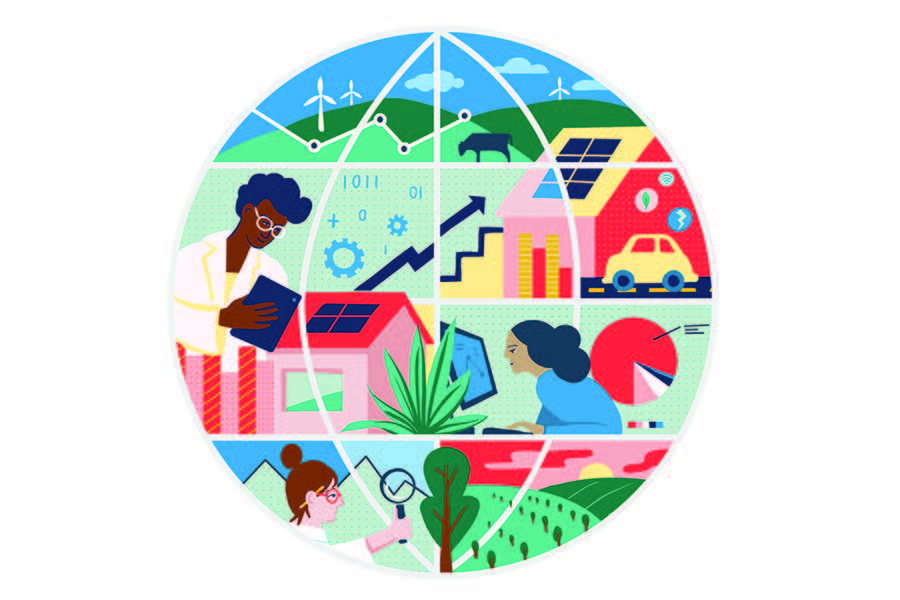
Upgrading computational tools for sustainable development
PNAS special feature shows potential of recent modeling advances to improve sustainability decision-making
Zero hunger. Affordable and clean energy. Reduced inequalities. These are among the sustainable development goals that the United Nations has established in pursuit of the long-term well-being of the Earth and its inhabitants. But achieving goals like these—whether by the UN’s 2030 deadline or beyond—requires a detailed understanding of the many complex, interconnected, co-evolving natural, social and technological systems upon which all life depends. Computational modeling methods and tools that incorporate that understanding can help project the likely future of those systems under different scenarios, and thus guide decision-makers in designing action plans that target sustainable development goals.
A case in point is a new approach to modeling the uptake of flood-proofing and other climate adaptation measures promoted by government policymakers to homeowners. A recent study shows that household decisions on such measures are based not only on economic status but also on social pressures and information consumption patterns. Incorporating these additional factors in climate adaptation modeling would give policymakers more precise projections of the likely effectiveness and economic impact of promoting a particular adaptation measure.
This is one of several recent modeling advances showcased in ten research articles and two perspectives appearing in the new Modeling Dynamic Systems for Sustainable Development Special Feature issue of the journal PNAS. These advances could significantly improve researchers’ ability to understand complex nature-society dynamics across decades, and decision-makers’ ability to apply that understanding to design and assess plans that could help meet sustainable development challenges.
“Much recent research in sustainability science has combined data and theory to better understand natural and societal systems—people, technologies, institutions, ecosystems and more—and how they interact,” says Noelle Selin, co-organizer of the special feature and a professor at MIT’s Institute for Data, Systems and Society, and Department of Earth, Atmospheric and Planetary Sciences. “Innovative modeling approaches allow scientists to make more accurate long-term projections about nature-society interactions and thereby better position decision-makers to evaluate the effectiveness of interventions aimed at achieving sustainability.”
Improved projections of complex, dynamic nature-society systems
In the Special Feature’s introduction, its three co-coordinators (Selin; Amanda Giang, a professor at the Institute for Resources, Environment and Sustainability, and Department of Mechanical Engineering at the University of British Columbia in Vancouver; and William C. Clark, a professor at the John F. Kennedy School of Government at Harvard University) articulate four stages of modeling practice—defining the purpose of modeling, selecting components, analyzing interactions, and assessing interventions. Citing selected studies that appear in the issue, they show how recent innovations in each of these modeling stages have improved understanding of nature-society system dynamics, and informed decision-making in pursuit of sustainable development goals.
First, models are typically designed to achieve a particular objective for a specific user community. But some models can be repurposed to address a broader set of challenges and stakeholders, including in the sustainability space. A Special Feature study on water infrastructure planning combines a conventional model of long-term climate trends with an innovative model that accounts for the effects of shorter-term climate oscillations on the water supply, along with other dynamic modeling techniques. The repurposed model provides decision-makers with the flexibility to add water-storage capacity incrementally if the climate becomes warmer and drier, and avoid building unneeded infrastructure, thereby reducing lifetime system costs.
Second, nature-society models have recently been developed that represent much more detail in human activities and environmental processes. These models include sustainability-relevant model components that simulate interactions among different societal actors and their surroundings. One Special Feature study introduces a modeling approach that represents system components, interactions and structure, and applies it to support food production in Pakistan’s Indus River basin. Model results pinpoint potential food system vulnerabilities and pathways associated with sustained food production.
Third, models are now more effectively capturing the complex, adaptive nature of the dynamics of nature-society systems by addressing uncertainties and computational challenges associated with feedback behavior, threshold processes, adaptive responses and other factors. One key challenge in this effort is to identify cause-and-effect relationships within and among nature-society systems. Citing examples ranging from air pollution regulation to the spread of Covid-19, a Special Feature study on causation shows how integrating observational and modeling approaches can shed light on these relationships.
“The latest innovations in these three stages of modeling practice position sustainability scientists represent complex nature-society systems more fully and ask a wider range of questions about these systems,” says Giang. “As a result, our findings can provide more robust guidance to decision-makers who seek to achieve sustainable development goals.”
Improved guidance for designing sustainable development action plans
Finally, some of today’s nature-society models are more capable of assessing interventions aimed at achieving sustainability-relevant goals, as they account for unanticipated responses that might occur in social processes in which actions by one set of actors induce responses by others. One Special Feature study illustrates this effect in the case of road freight, where policy interventions in one country to advance low-carbon strategies can encourage innovation, which then can “spill over” to other regions. The study shows that the potential for these effects is larger where policies are introduced in large regions or combinations of regions, using a generalizable model that could help decision-makers better assess the effects of national policies on global technological change.
“Through this Special Feature highlighting diverse advances in the modeling of nature-society systems, we hope to encourage both further methodological research and wider adoption of newer modeling approaches that together will help decision-makers to design action plans that better support the pursuit of sustainability,” says Clark.
Several researchers affiliated with the MIT Joint Program on the Science and Policy of Global Change contributed to the Special Feature, including Noelle Selin and Amanda Giang.
Image: This PNAS Special Feature shows the potential of recent modeling advances to improve decision-making in pursuit of a more sustainable world. (Source: PNAS)
